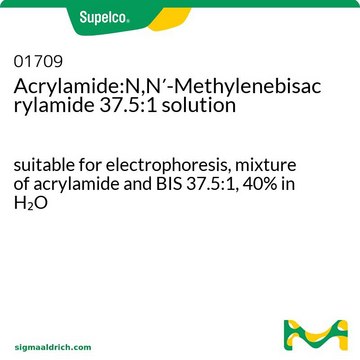A6050
Acrylamide/Bis-acrylamide
BioReagent, for molecular biology, 37:1 (ratio)
Sinónimos:
Acrylamide/Bisacrylamide, 37:1 (2.6% crosslinker), Polyacrylamide solution
About This Item
Productos recomendados
grade
for molecular biology
Quality Level
product line
BioReagent
form
powder
feed ratio
37:1 (ratio)
foreign activity
DNase, RNase and protease, none detected
SMILES string
NC(=O)C=C.C=CC(=O)NCNC(=O)C=C
InChI
1S/C7H10N2O2.C3H5NO/c1-3-6(10)8-5-9-7(11)4-2;1-2-3(4)5/h3-4H,1-2,5H2,(H,8,10)(H,9,11);2H,1H2,(H2,4,5)
InChI key
OCQZXMCGTAWGEQ-UHFFFAOYSA-N
¿Está buscando productos similares? Visita Guía de comparación de productos
General description
Application
Features and Benefits
Reconstitution
For the 1 Liter size, use 630 mL of water.
related product
signalword
Danger
Hazard Classifications
Acute Tox. 3 Oral - Acute Tox. 4 Dermal - Acute Tox. 4 Inhalation - Carc. 1B - Eye Irrit. 2 - Muta. 1B - Repr. 2 - Skin Irrit. 2 - Skin Sens. 1 - STOT RE 1 Oral
target_organs
Peripheral nervous system
Storage Class
6.1C - Combustible acute toxic Cat.3 / toxic compounds or compounds which causing chronic effects
wgk_germany
WGK 3
flash_point_f
Not applicable
flash_point_c
Not applicable
ppe
Eyeshields, Faceshields, Gloves, type P2 (EN 143) respirator cartridges
Certificados de análisis (COA)
Busque Certificados de análisis (COA) introduciendo el número de lote del producto. Los números de lote se encuentran en la etiqueta del producto después de las palabras «Lot» o «Batch»
¿Ya tiene este producto?
Encuentre la documentación para los productos que ha comprado recientemente en la Biblioteca de documentos.
Los clientes también vieron
Nuestro equipo de científicos tiene experiencia en todas las áreas de investigación: Ciencias de la vida, Ciencia de los materiales, Síntesis química, Cromatografía, Analítica y muchas otras.
Póngase en contacto con el Servicio técnico





